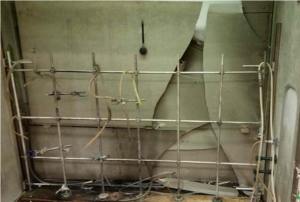 On Sunday, January 28, 2018, there was a significant explosion in a chemistry laboratory. Fortunately, no one was injured due to the laboratory being vacant at the moment of the explosion, but the fume hood where it occurred was severely damaged. The safety sash, which consists of four safety glass panels at the front of the fume hood, was found destroyed when a student returned to the laboratory – three of the panels were completely displaced and found lying on the floor. The transite panels that line the back of the fume hood were cracked into several pieces as well.
On Sunday, January 28, 2018, there was a significant explosion in a chemistry laboratory. Fortunately, no one was injured due to the laboratory being vacant at the moment of the explosion, but the fume hood where it occurred was severely damaged. The safety sash, which consists of four safety glass panels at the front of the fume hood, was found destroyed when a student returned to the laboratory – three of the panels were completely displaced and found lying on the floor. The transite panels that line the back of the fume hood were cracked into several pieces as well.

Upon investigation, the explosion was determined to be caused by a closed valve on a distillation apparatus. The closed valve prevented circulation of gas allowing heat and pressure to build up inside. According to the Laboratory Accident Investigation Report prepared by Environmental Health and Safety, it is suspected that the pressure buildup caused the condensing coil to pop out of the top of the column, allowing oxygenated air to enter the apparatus. Once the super-heated gas came in contact with the oxygen, a flash explosion occurred.
The student involved in the incident was fully trained in the distillation procedure as well as all standard laboratory safety (Laboratory Chemical Safety Training including emergency response and hands-on Fire Extinguisher Training), and thus was able to respond to the emergency appropriately.

It was by mere chance that the laboratory was empty at the time of the explosion. However, not all researchers are blessed by such luck. In 2014, a graduate student at the University of Minnesota received second-degree burns and glass injuries to his arms and side from an explosion due to insufficient recognition of his chemical reaction’s hazards. And in 2016, a postdoctoral researcher at the University of Hawaii lost her arm due to the use of a gas valve that was not rated for the flammable gases her experiment required.
Even though this recent explosion caused no bodily harm, it nonetheless underscores the importance of laboratory safety practices. As researchers, it is our responsibility to practice and promote safety in campus laboratories. So what does this mean?
For undergraduate students: Take safety protocols seriously in your laboratory-based classes. Although your labs are designed to have minimal risk, it can never be eliminated completely. The program is designed to slowly develop your safety skills and knowledge. Embrace those goggle lines! Wear your goggles and make sure your friends do too.
For graduate students: Before trying a new experiment or even an old one, make sure you understand the procedure and any safety precautions you need to take. Graduate school causes us all the occasional late night, so use the buddy system and make sure someone is around to help if something were to go wrong. Promote safety as an associate instructor by example.
For faculty: Maintain a safety-positive environment. Verify that your students are up to date on their safety training and implementing safety on a daily basis in the laboratory. Be sure to review emergency procedures with your students to prepare them for the unlikely event that something goes wrong.
To prevent the recurrence of the recent explosion, the valve which prevents circulation in the distillation apparatus will be removed from all like apparatuses on campus. This will create an open system allowing the gas to circulate and cool properly. In addition, an emphasis has been placed on completing potentially hazardous chemical reactions during normal working hours when possible.
Edited by Lana Ruck, Maria Tiongco, and Victoria Kohout

Leave a Reply